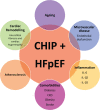Clonal haematopoiesis of indeterminate potential: intersections between inflammation, vascular disease and heart failure
- PMID: 33861346
- PMCID: PMC8055963
- DOI: 10.1042/CS20200306
Clonal haematopoiesis of indeterminate potential: intersections between inflammation, vascular disease and heart failure
Abstract
Ageing is a major risk factor for the development of cardiovascular disease (CVD) and cancer. Whilst the cumulative effect of exposure to conventional cardiovascular risk factors is important, recent evidence highlights clonal haematopoiesis of indeterminant potential (CHIP) as a further key risk factor. CHIP reflects the accumulation of somatic, potentially pro-leukaemic gene mutations within haematopoietic stem cells over time. The most common mutations associated with CHIP and CVD occur in genes that also play central roles in the regulation of inflammation. While CHIP carriers have a low risk of haematological malignant transformation (<1% per year), their relative risk of mortality is increased by 40% and this reflects an excess of cardiovascular events. Evidence linking CHIP, inflammation and atherosclerotic disease has recently become better defined. However, there is a paucity of information about the role of CHIP in the development and progression of heart failure, particularly heart failure with preserved ejection fraction (HFpEF). While systemic inflammation plays a role in the pathophysiology of both heart failure with reduced and preserved ejection fraction (EF), it may be of greater relevance in the pathophysiology of HFpEF, which is also strongly associated with ageing. This review describes CHIP and its pathogenetic links with ageing, inflammation and CVD, while providing insight into its putative role in HFpEF.
Keywords: ageing; atherosclerosis; cardiovascular disease; clonal haematopoiesis of indeterminate potential; heart failure.
© 2021 The Author(s).
Conflict of interest statement
C.G. has received research funding from AstraZeneca, Bristol-Myers Squibb, ISTESSO, Eli-Lilly, MedAnnex, Pfizer and UCB. C.G. is/has been an advisory board member for Bristol-Myers Squibb, MedAnnex, Medincell and Pfizer and has received honoraria from Abbvie and Bristol-Myers Squibb. M.C.P. has received research funding from Novartis, Bristol-Myers Squibb, Cyclacel and Takeda/Incyte, is/has been an advisory board member for Bristol-Myers Squibb, Novartis, Incyte, Daiichi Sankyo, Jazz and Pfizer and has received honoraria from Astellas, Bristol-Myers Squibb, Novartis, Incyte, Pfizer and Gilead. M.C.P. has received research grants or consultancy fees from SQ Innovations, AstraZeneca, Roche, Boehringer Ingelheim, Eli Lilly, Napp Pharmaceuticals, Novartis, and Novo Nordisk and has served on clinical events committees for AbbVie, Alnylam, Astra Zeneca, Bayer, Boehringer Ingelheim, GlaxoSmithKline, Resverlogix, and Novo Nordisk. N.N.L. has received research funding from Roche Diagnostics, Bristol-Myers Squibb, is/has been an advisory board member for Vifor Pharma, Pharmacosmos and has received honoraria from Roche Diagnostics, Takeda, Pfizer and Novartis.
Figures



Similar articles
-
Biomarkers in clonal haematopoiesis of indeterminate potential (CHIP) linking cardiovascular diseases, myeloid neoplasms and inflammation.Ann Hematol. 2025 Mar;104(3):1355-1366. doi: 10.1007/s00277-025-06244-x. Epub 2025 Feb 24. Ann Hematol. 2025. PMID: 39988580 Free PMC article. Review.
-
Clonal Hematopoiesis of Indeterminate Potential From a Heart Failure Specialist's Point of View.J Am Heart Assoc. 2023 Aug;12(15):e030603. doi: 10.1161/JAHA.123.030603. Epub 2023 Jul 25. J Am Heart Assoc. 2023. PMID: 37489738 Free PMC article. Review.
-
[Heart and blood: clonal hematopoiesis].Herz. 2024 Mar;49(2):105-110. doi: 10.1007/s00059-024-05237-2. Epub 2024 Feb 29. Herz. 2024. PMID: 38424288 Review. German.
-
Clonal haematopoiesis: connecting ageing and inflammation in cardiovascular disease.Nat Rev Cardiol. 2020 Mar;17(3):137-144. doi: 10.1038/s41569-019-0247-5. Epub 2019 Aug 12. Nat Rev Cardiol. 2020. PMID: 31406340 Free PMC article. Review.
-
Putative Mechanisms Underlying Cardiovascular Disease Associated with Clonal Hematopoiesis of Indeterminate Potential.Stem Cell Reports. 2020 Aug 11;15(2):292-306. doi: 10.1016/j.stemcr.2020.06.021. Epub 2020 Jul 30. Stem Cell Reports. 2020. PMID: 32735822 Free PMC article. Review.
Cited by
-
Interplay between chronic inflammation and clonal haematopoiesis of indeterminate potential in Behçet's disease.Arthritis Res Ther. 2023 Mar 2;25(1):33. doi: 10.1186/s13075-023-03014-w. Arthritis Res Ther. 2023. PMID: 36864496 Free PMC article.
-
Inflammatory Mechanisms in Heart Failure with Preserved Ejection Fraction.Physiology (Bethesda). 2023 Sep 1;38(5):0. doi: 10.1152/physiol.00004.2023. Epub 2023 Apr 4. Physiology (Bethesda). 2023. PMID: 37013947 Free PMC article. Review.
-
Modern Concepts in Cardiovascular Disease: Inflamm-Aging.Front Cell Dev Biol. 2022 May 18;10:882211. doi: 10.3389/fcell.2022.882211. eCollection 2022. Front Cell Dev Biol. 2022. PMID: 35663390 Free PMC article. Review.
-
Mechanisms shared between cancer, heart failure, and targeted anti-cancer therapies.Cardiovasc Res. 2023 Feb 3;118(18):3451-3466. doi: 10.1093/cvr/cvac132. Cardiovasc Res. 2023. PMID: 36004495 Free PMC article. Review.
-
A Comparison of Bone Marrow Morphology and Peripheral Blood Findings in Low and High Level JAK2 V617F Allele Burden.Diagnostics (Basel). 2023 Jun 16;13(12):2086. doi: 10.3390/diagnostics13122086. Diagnostics (Basel). 2023. PMID: 37370982 Free PMC article.
References
-
- Department of Health (2017) Health Survey for Engand: Cardiovascualar Diseases. pp. 1–25, http://healthsurvey.hscic.gov.uk/media/78646/HSE17-CVD-rep.pdf
-
- Cancer Research U.K. (2015-2017) Cancer incidence by age. Data is for UK, pp. 1–52, https://www.cancerresearchuk.org/health-professional/cancer-statistics/i...
Publication types
MeSH terms
LinkOut - more resources
Full Text Sources
Other Literature Sources
Medical

